Integrating Sustainable Energy Development with Energy Ecosystems: Trends and Future Prospects in Greece
Abstract
1. Introduction
2. Theoretical Background
2.1. The Concept of Sustainable Energy Development
2.2. Energy Ecosystems in Retrospect
2.2.1. Evolutionary Economics, the Macro–Meso–Micro Framework, and the Ecosystem Metaphor
2.2.2. The Supplier–Producer–Distributor–Consumer Nexus
3. Methodology
3.1. Sampling and Expert Interviews
3.2. Data Collection Process and Instruments
- Macrolevel questions:
- Global shifts and new players: “In your view, why are new players focusing on solar and wind gaining geopolitical clout compared to traditional fossil-fuel producers?”
- Long-term global outlook: “How do you foresee the energy sector evolving globally by 2050, and why?”
- Demographic–environmental context: “The EU and Greece have moderate performance in meeting the Paris Agreement temperature goals for 2030. Why do you think that is?”
- Cultural acceptance: “There seems to be increasing acceptance of nuclear energy in Europe nowadays. What do you think explains this trend?”
- Political stability: “Greece ranks low on political stability measures. Why do you think that continues?”
- Financing renewables in developed vs. developing regions: “Investments in renewables for developed countries and China are set to rise significantly by 2030, while those in many developing nations lag. Why might that be?”
- Energy storage: “Battery energy storage investments in the EU are lower compared to the US and China. Why do you think this disparity exists?”
- Environmental research and development (R&D) in Greece: “Greece shows low performance in environmental technologies and public R&D investments. What factors do you believe contribute to this?”
- Mesolevel questions:
- 9.
- Suppliers and price volatility: “What do you see as the main drivers of recent extreme fluctuations in fossil-fuel prices?”
- 10.
- Greek fossil-fuel dependence: “Why does Greece fail to produce sufficient domestic fossil-fuel resources and depend on particular external suppliers?”
- 11.
- Producers and renewables: “The EU and Greece show higher shares of renewable capacity than much of the world. What do you think accounts for this?”
- 12.
- Convergence in electricity production: “Recent data show that per capita electricity generation in Greece is converging with the EU average. Why do you think this is happening?”
- 13.
- Distributors and digital platforms: “Greece lags in digital energy platforms but has relatively complete fossil-fuel infrastructure. What factors do you see behind this discrepancy?”
- 14.
- Productivity in fuel trading: “Fuel trading in Greece has lower labor productivity than other energy segments. Why might this be so?”
- 15.
- Consumers—energy use per capita: “We also see recent convergence between the EU and Greece in energy use per person. What do you attribute this to?”
- Microlevel questions:
- 16.
- Revenue increases in Greek energy firms: “Despite the reduced market share of the Public Power Corporation (ΔΕH), overall revenues in the Greek energy sector have risen. Why might that be?”
- 17.
- Patents and innovation: “Energy-related patents in Greece have declined recently. What underlying reasons do you see?”
- Integrative policy level:
- 18.
- Industry–government–university cooperation: “What do you believe should be the main directions for a new energy policy in Greece and the EU today?”
3.3. Limitations and Transferability
4. Results
4.1. The Sustainable Energy Mix in Greece
4.2. The Direction of the Greek Energy System Based on Recent Literature
4.3. Sustainable Energy Development in Greece
4.3.1. Access to Affordable Modern Energy Services
4.3.2. Sustainable Energy Supply
4.3.3. Sustainable Energy Consumption
4.3.4. Energy Security
4.3.5. Synthesis
- Access to affordable modern energy services: While Greece has expanded energy access, affordability remains an issue, particularly for vulnerable populations. Limited technological innovation and international collaboration hinder further advancement, as evidenced by its low ranking in the Global Energy Innovation Index.
- Sustainable energy supply: Significant strides have been made in reducing reliance on coal and oil, transitioning to renewable energy sources like solar and wind. Renewable energy now constitutes 43.17% of Greece’s electricity production, reflecting a clear pivot toward sustainability in line with EU trends.
- Sustainable energy consumption: Greece’s energy consumption patterns show a notable shift, with wind and solar energy replacing traditional fossil fuels. However, per capita energy use remains below the EU average, signaling potential for further improvements in efficiency and renewable integration.
- Energy security: Energy security remains a critical challenge, with Greece’s dependency on energy imports exceeding the EU average. Strengthening domestic production, diversifying supply sources, and addressing systemic inefficiencies are essential to mitigate risks.
4.4. The Greek Energy Ecosystem
4.4.1. Energy Supply
4.4.2. Energy Production
4.4.3. Energy Distribution
4.4.4. Energy Consumption
4.5. Synthesis with the Help of Expert Feedback
- Affordability and innovation: While Greece shows progress in broadening renewable capacity, many experts see innovation (particularly digital and grid-related) lagging—hindering greater cost competitiveness and stable supply. This underscores an urgent need for R&D support, regulatory clarity, and international partnerships to boost Greece’s place in the “knowledge development and diffusion” aspect of SED.
- Grid modernization and mesolevel coordination: Investments in the electricity grid, regional interconnectors, and digital distribution are pivotal to balancing supply, demand, and energy security. Here, public–private partnerships and agile regulation—mesolevel catalysts—can help overcome local resistance and high infrastructure costs.
- Policy harmonization and equity: Experts echoed the misalignment between national policies and EU-wide goals, as well as the importance of transparent pricing and targeted subsidies for vulnerable groups. A more synchronized policy approach can amplify the benefits of the EE framework—i.e., suppliers, producers, distributors, and consumers all adapting in tandem—while fulfilling SED imperatives for social equity.
5. Discussion
5.1. RQ1: Why Integrate the SED Concept with the EE Framework?
5.2. RQ2: Where Is the Greek Energy System Headed?
5.3. Toward a Resilient and Inclusive Path: Macro–Meso–Micro Policy Directions
6. Conclusions
Funding
Institutional Review Board Statement
Informed Consent Statement
Data Availability Statement
Conflicts of Interest
Appendix A


Appendix B
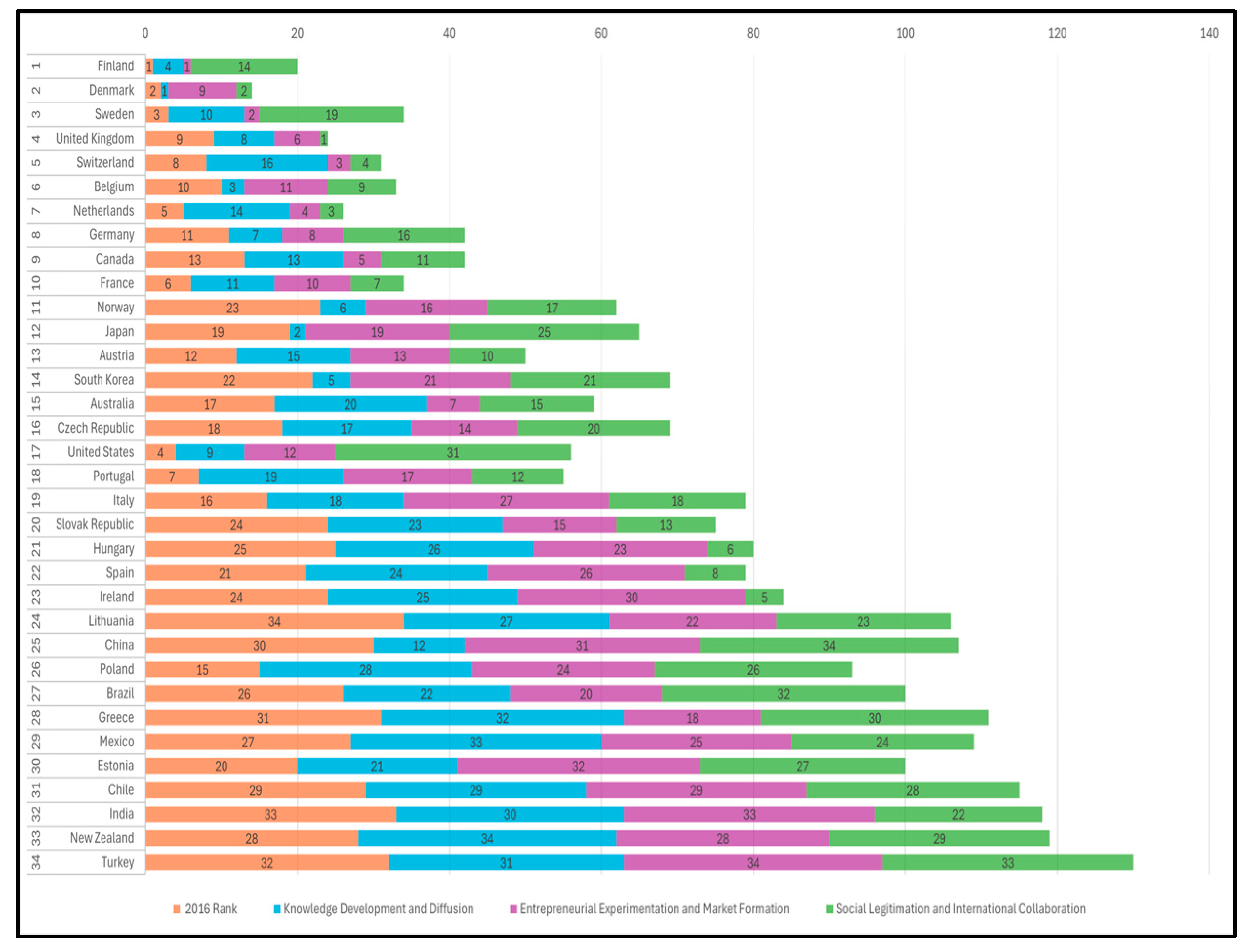

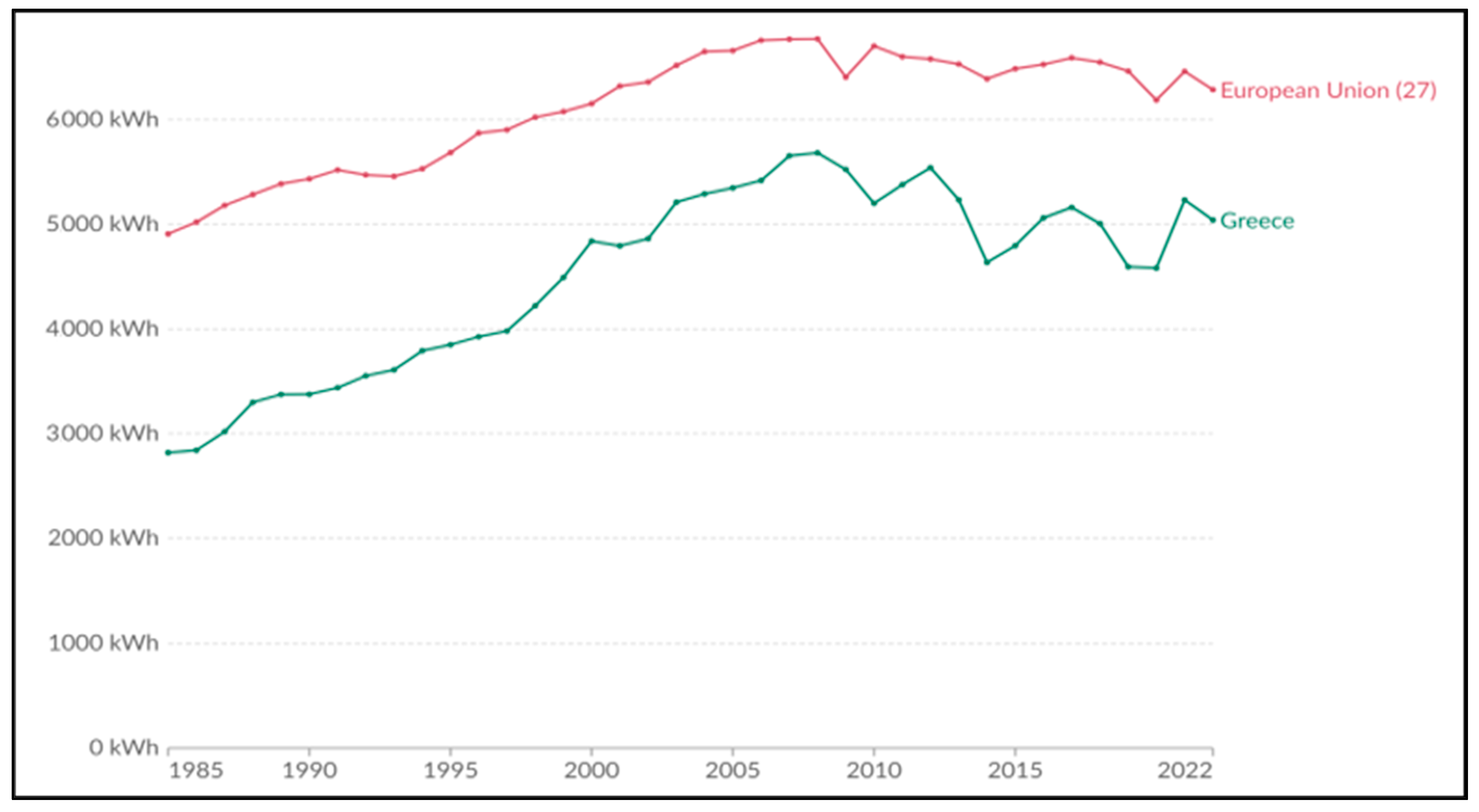
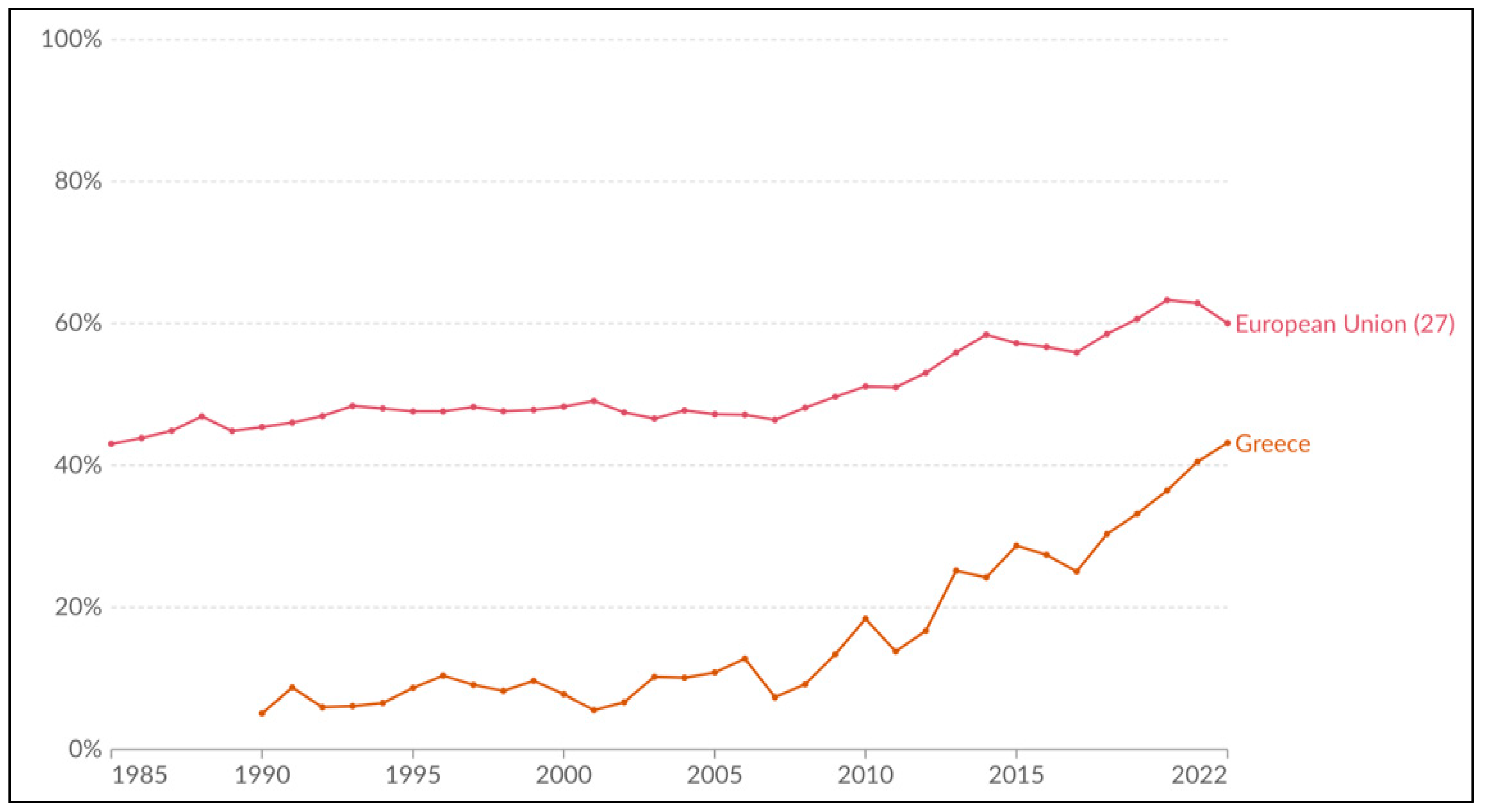
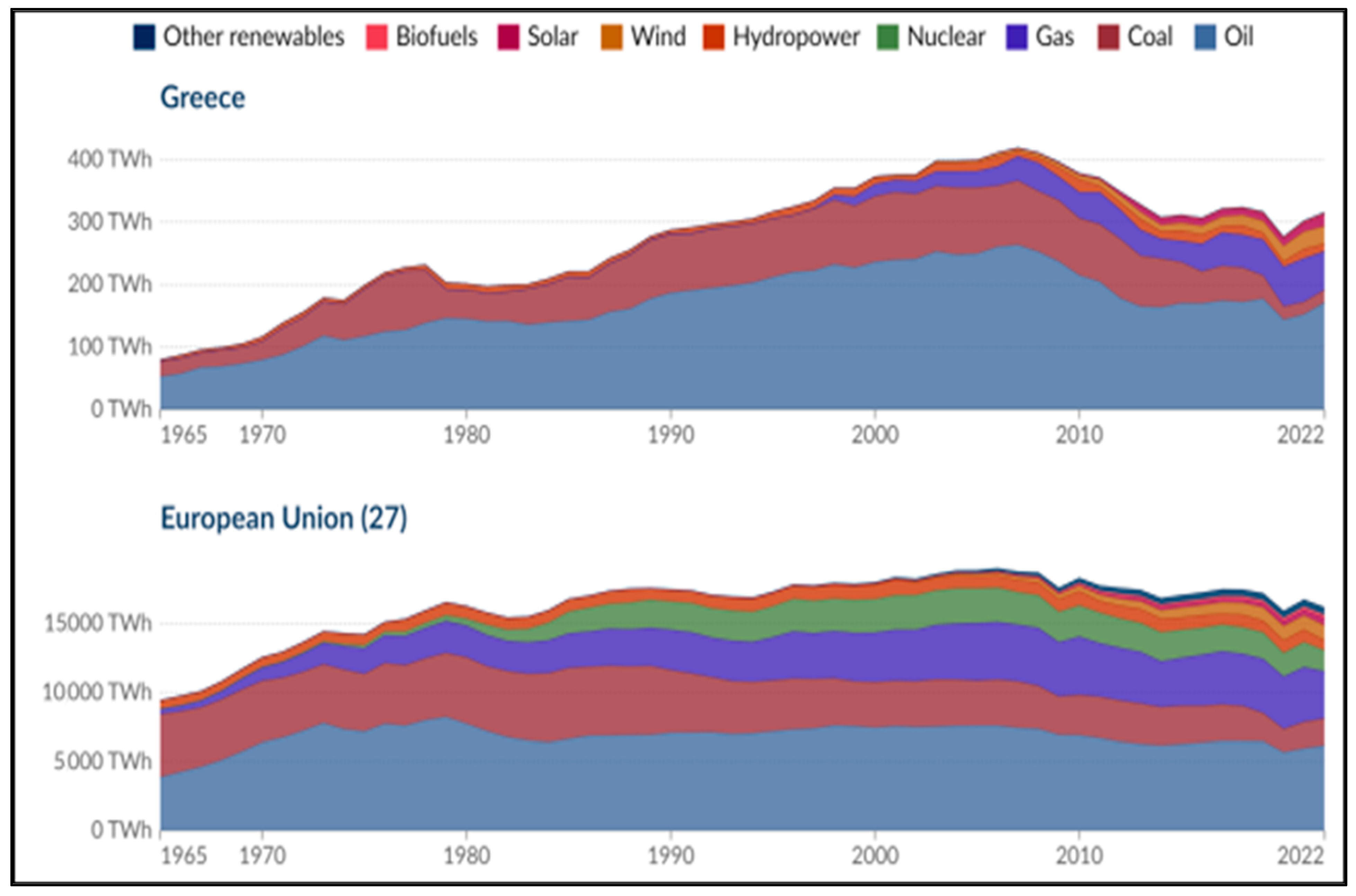
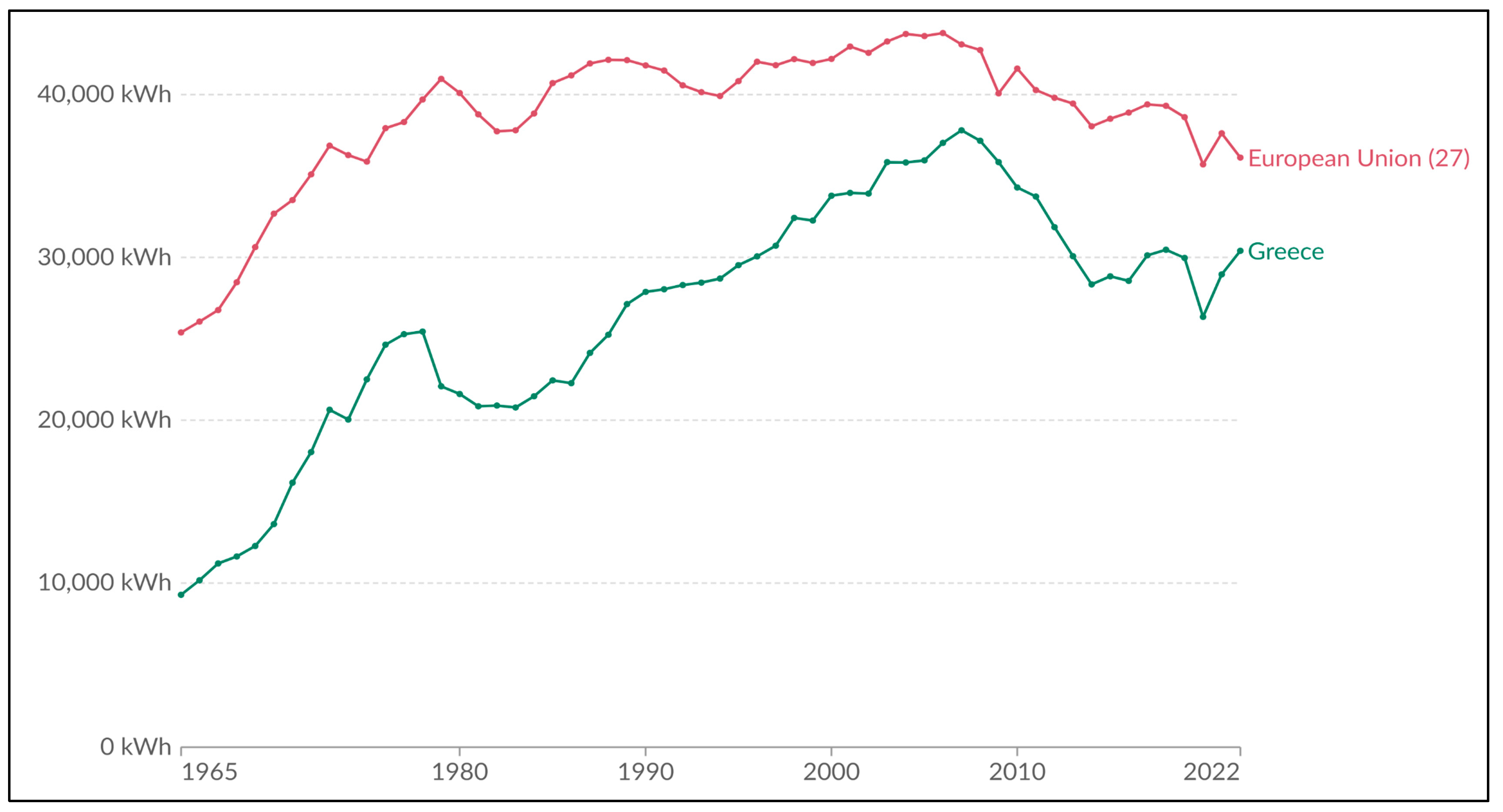


Appendix C
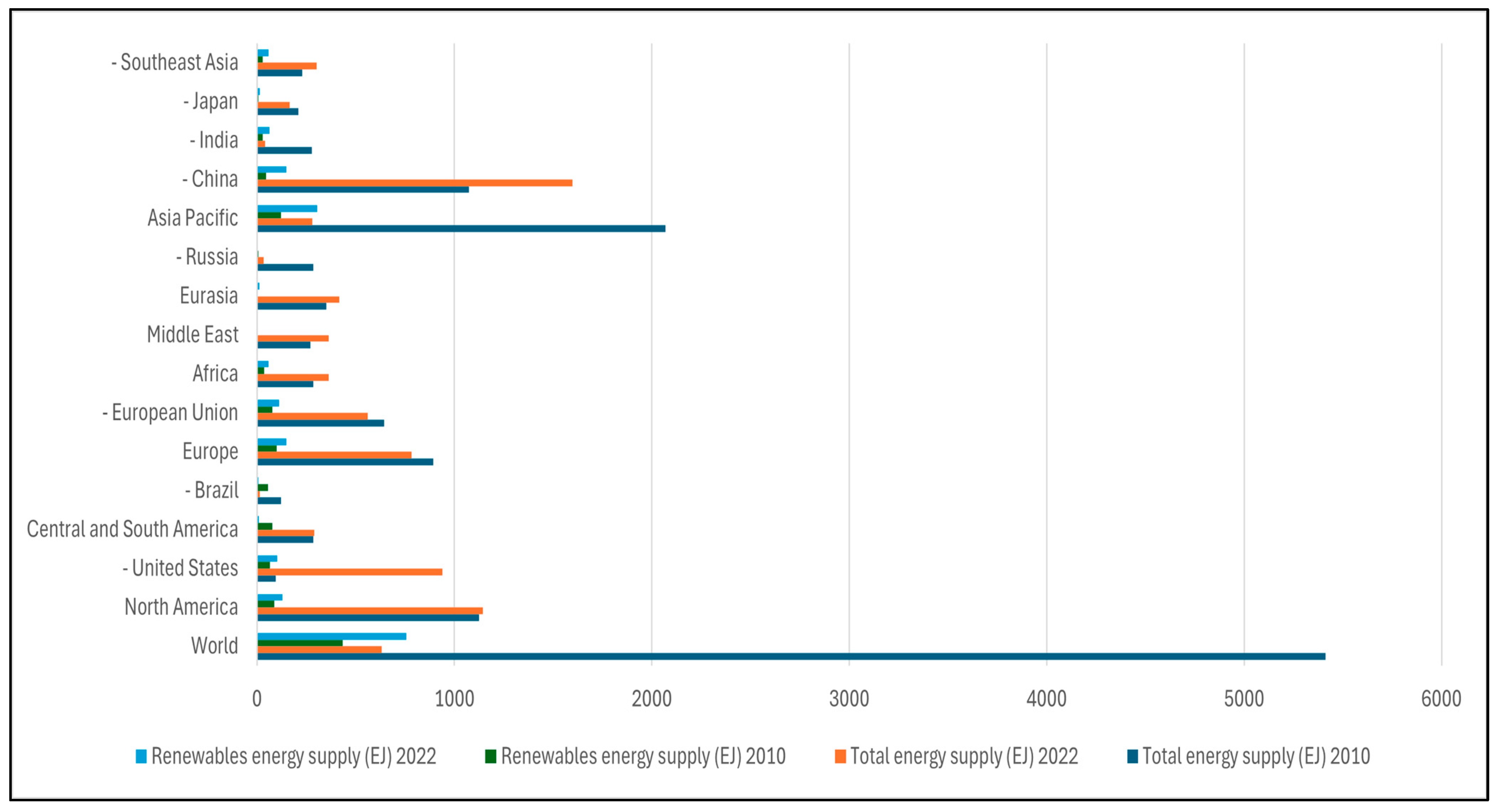
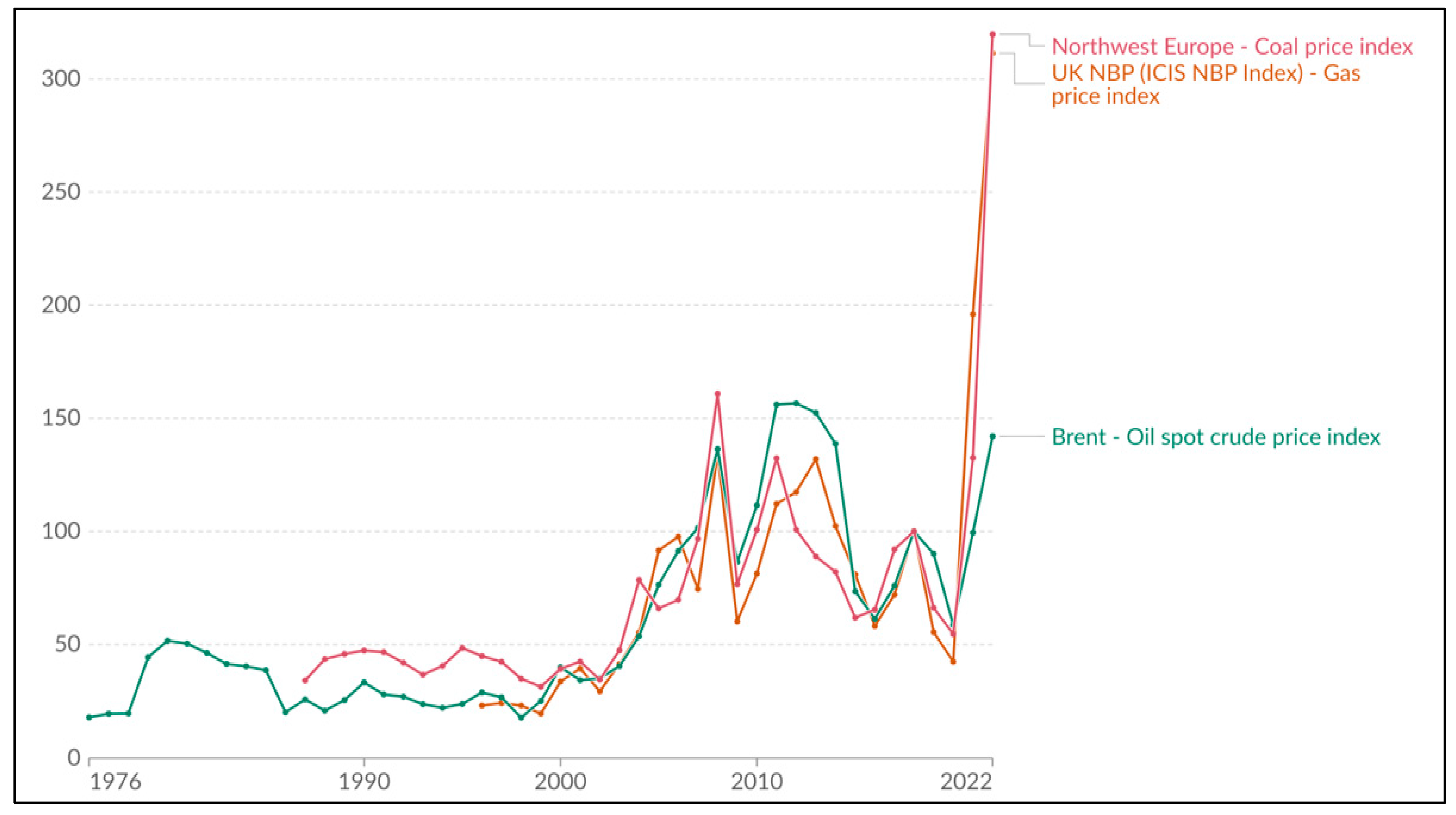

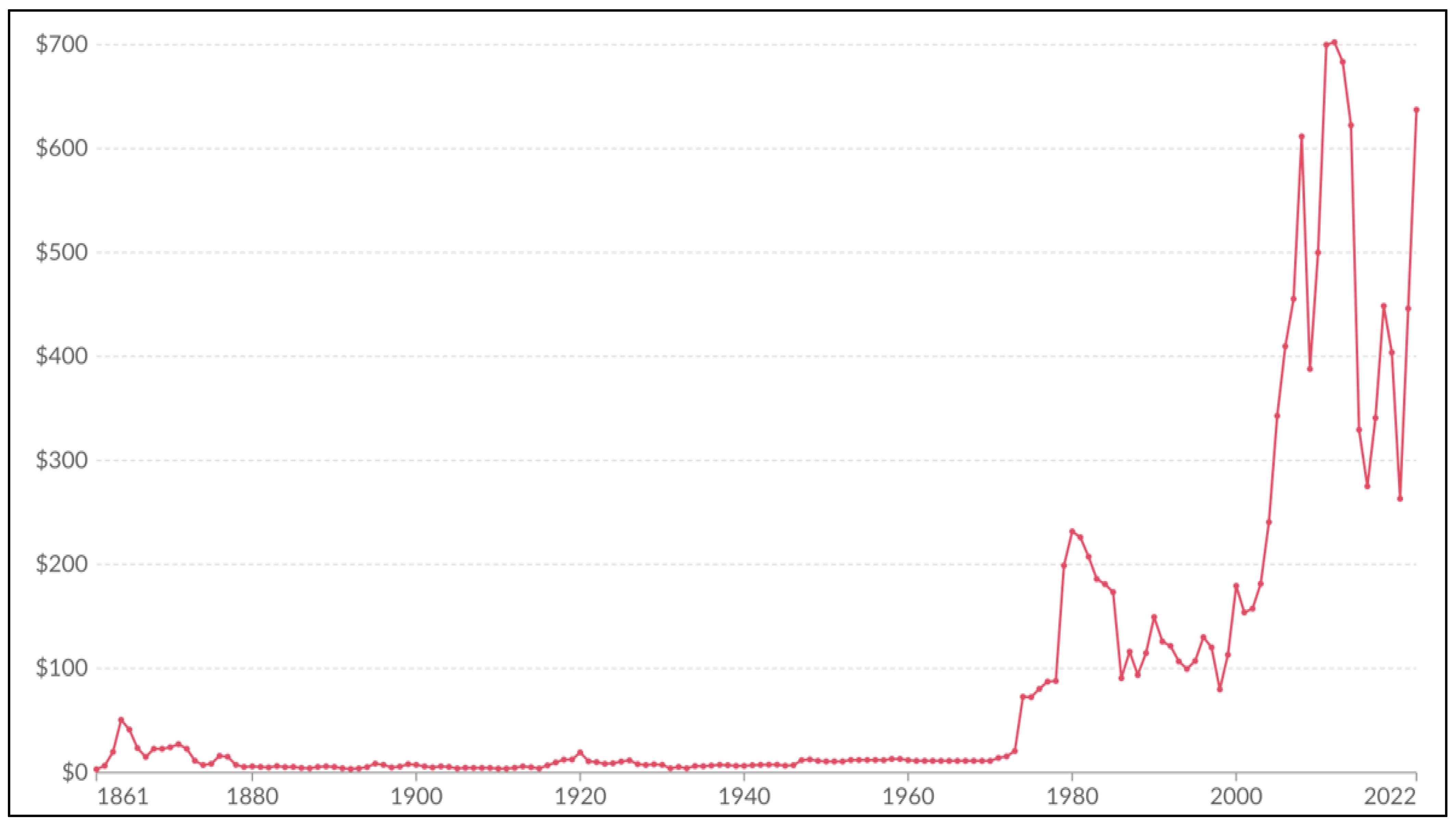
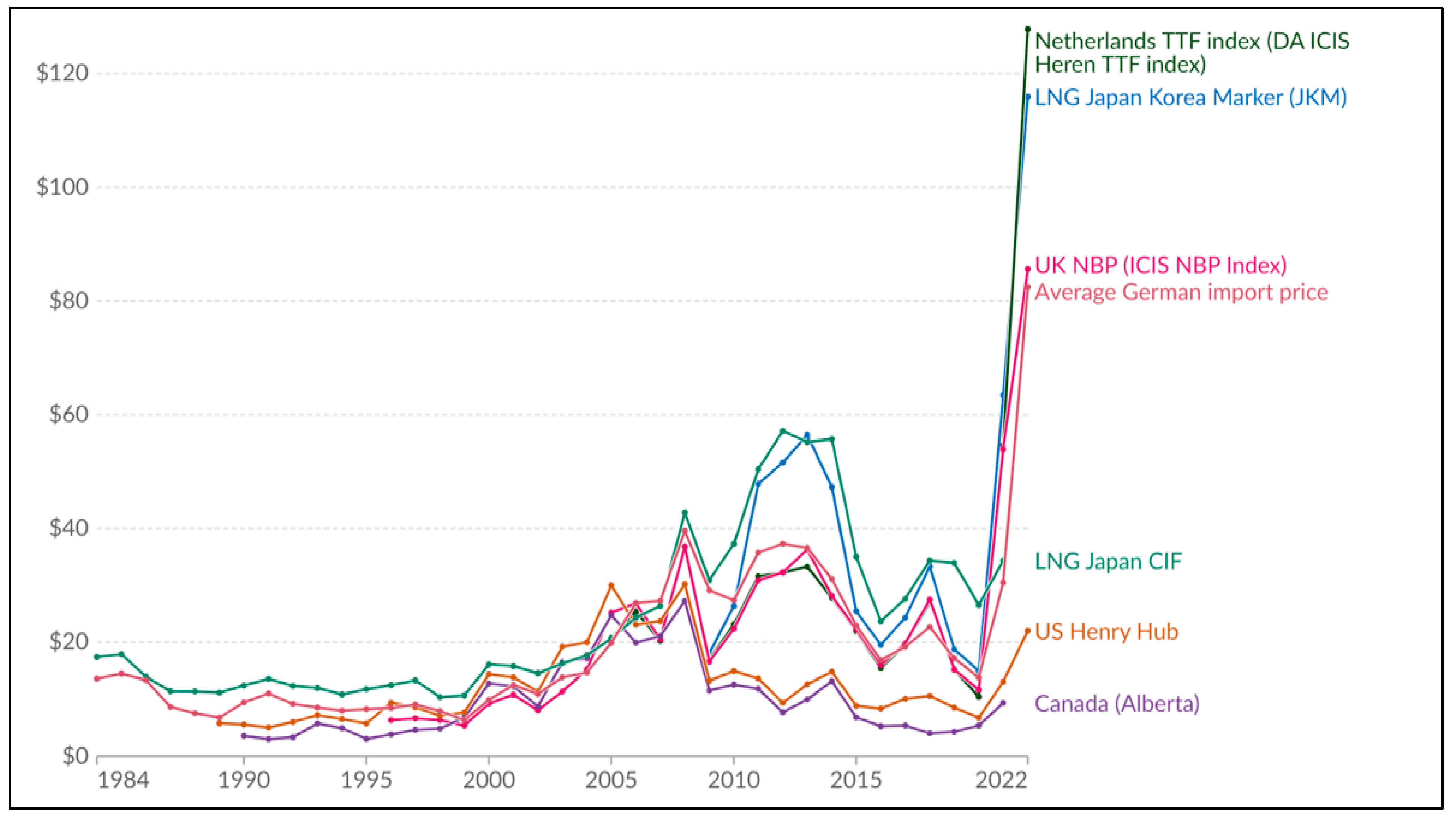
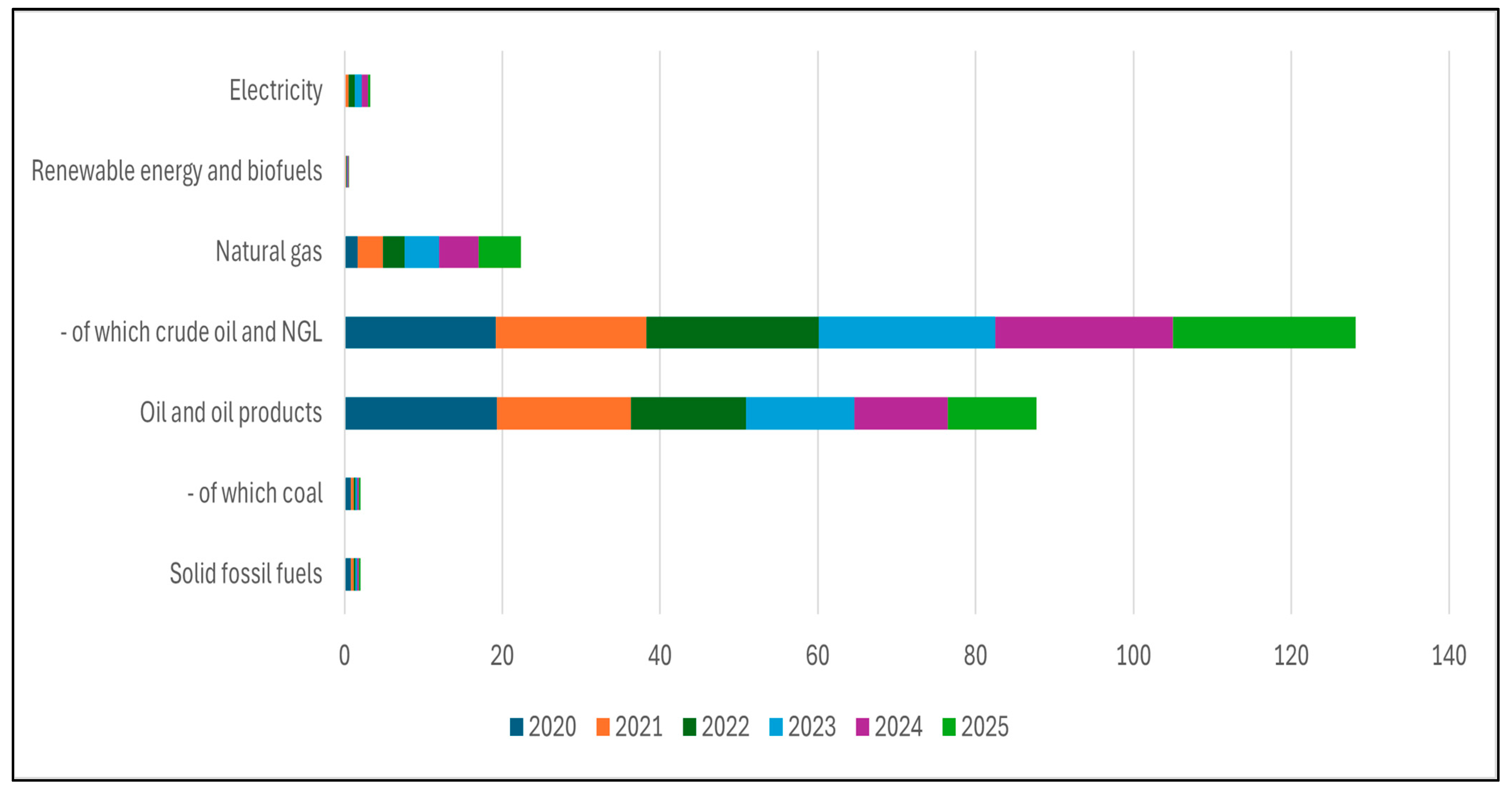
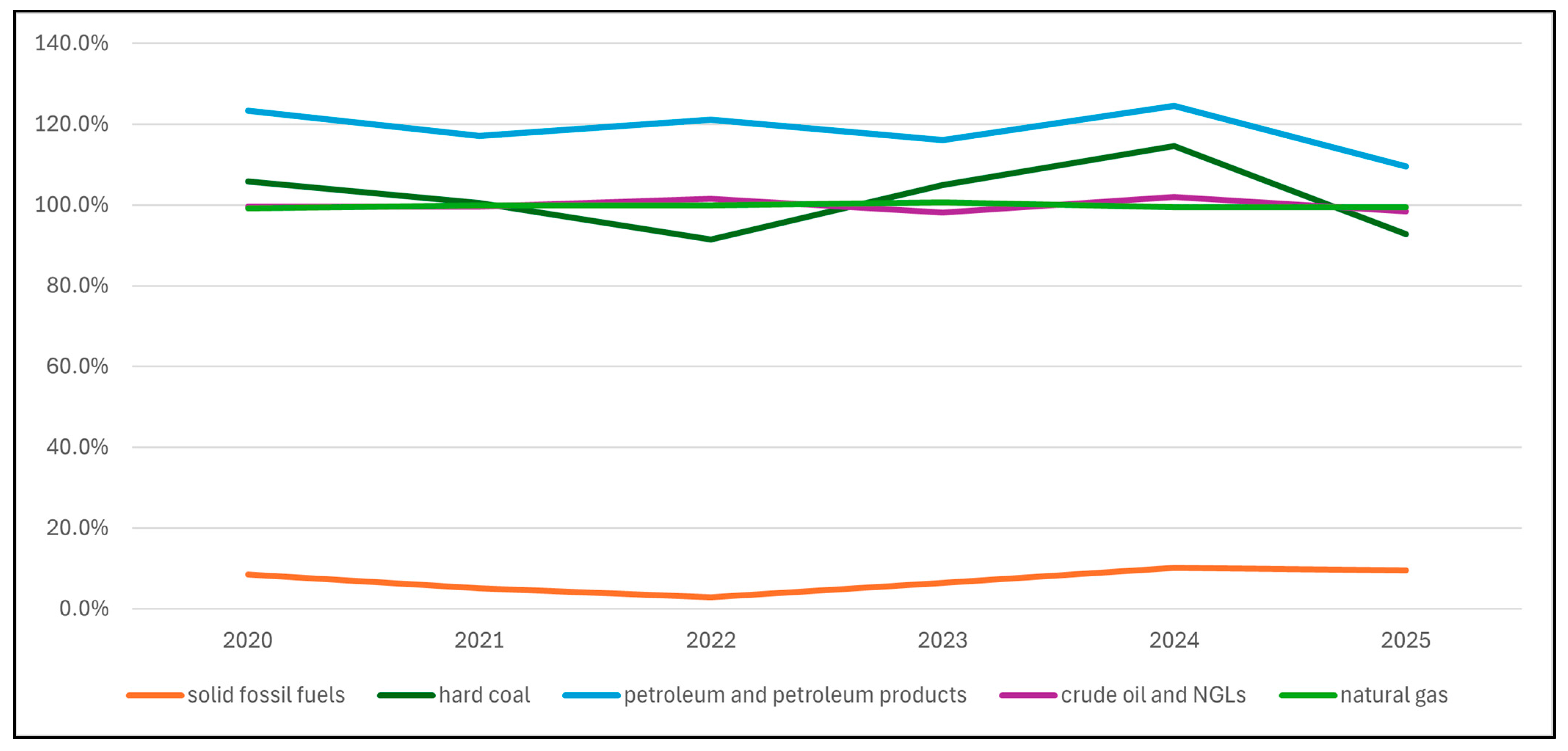
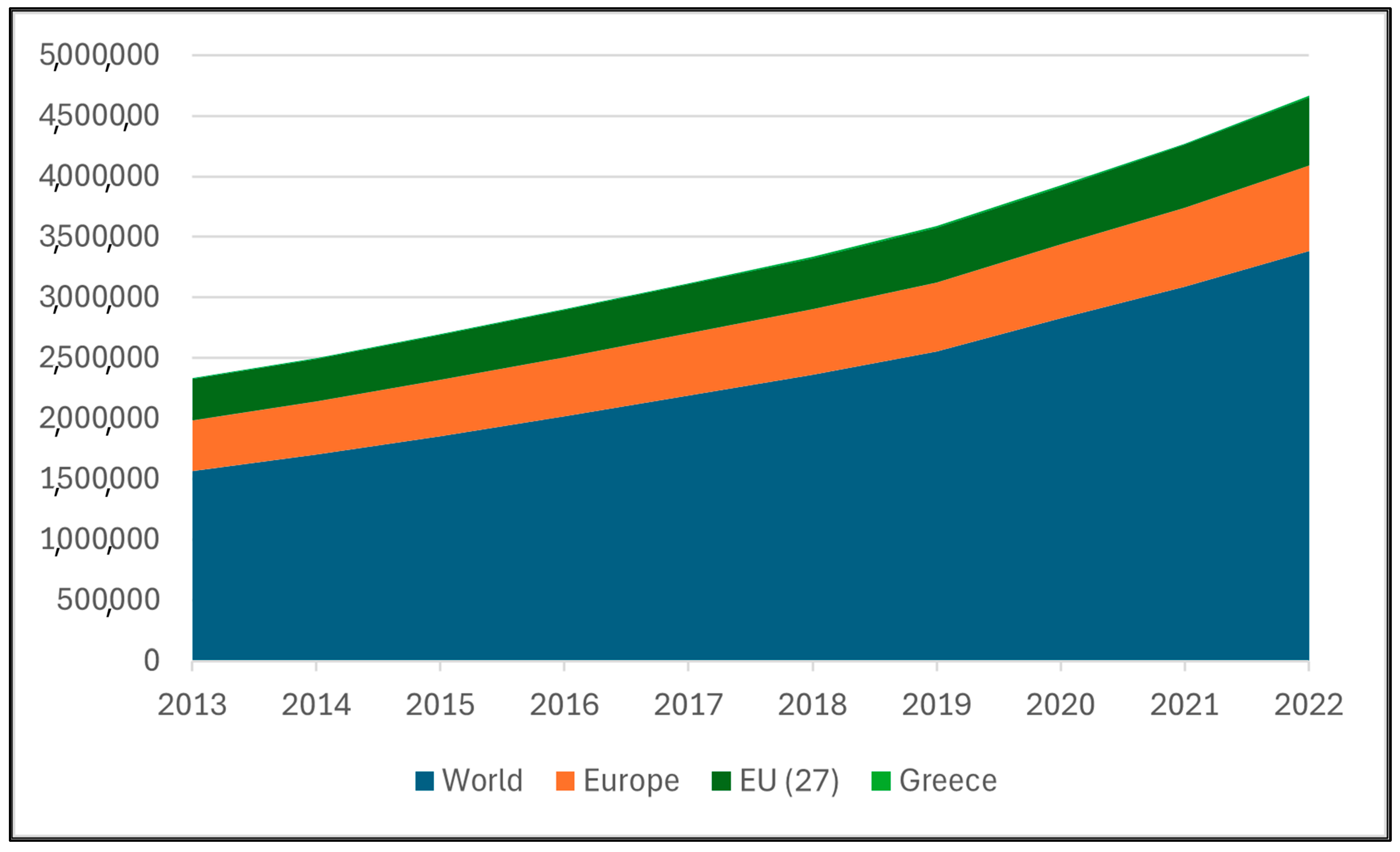
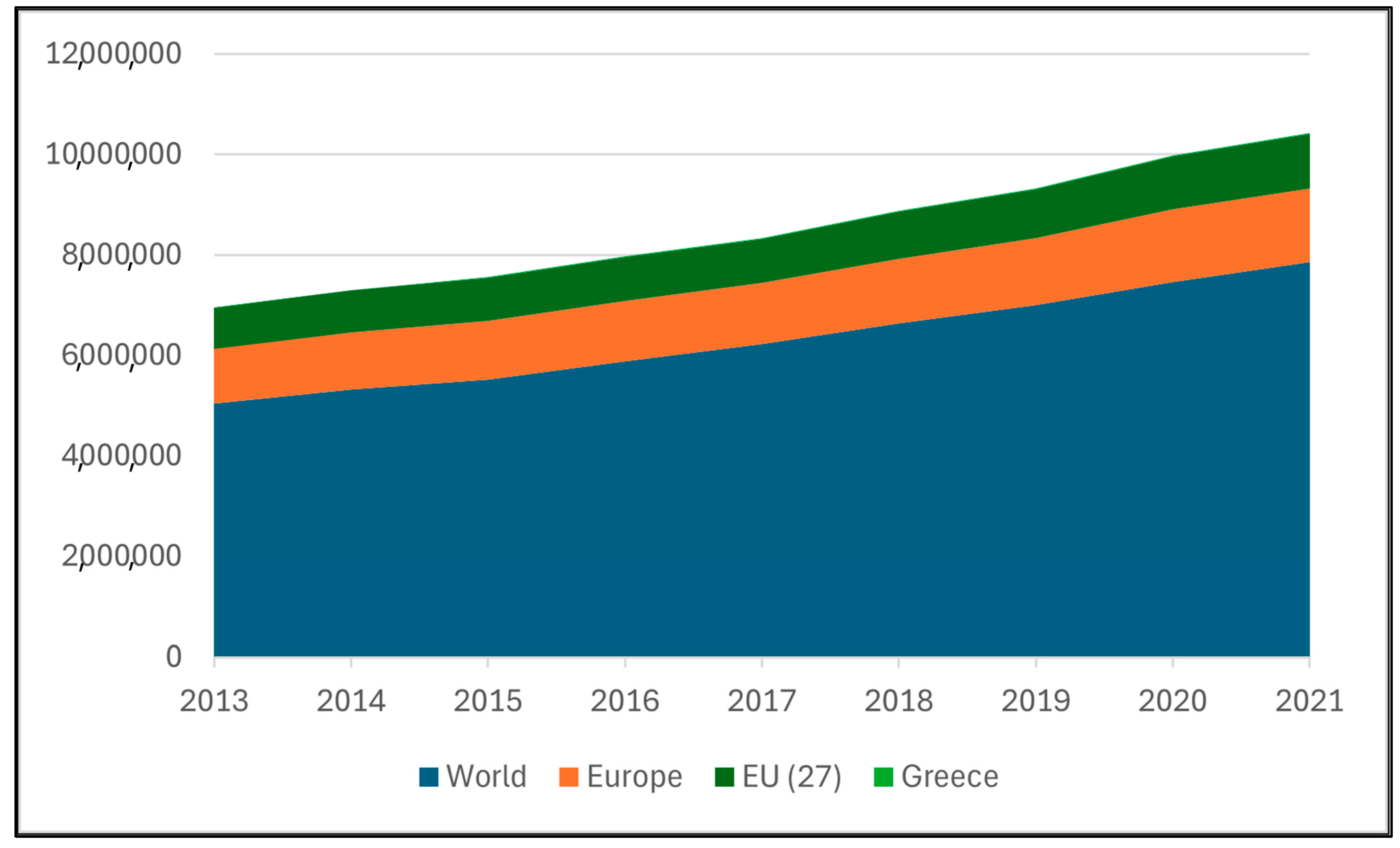

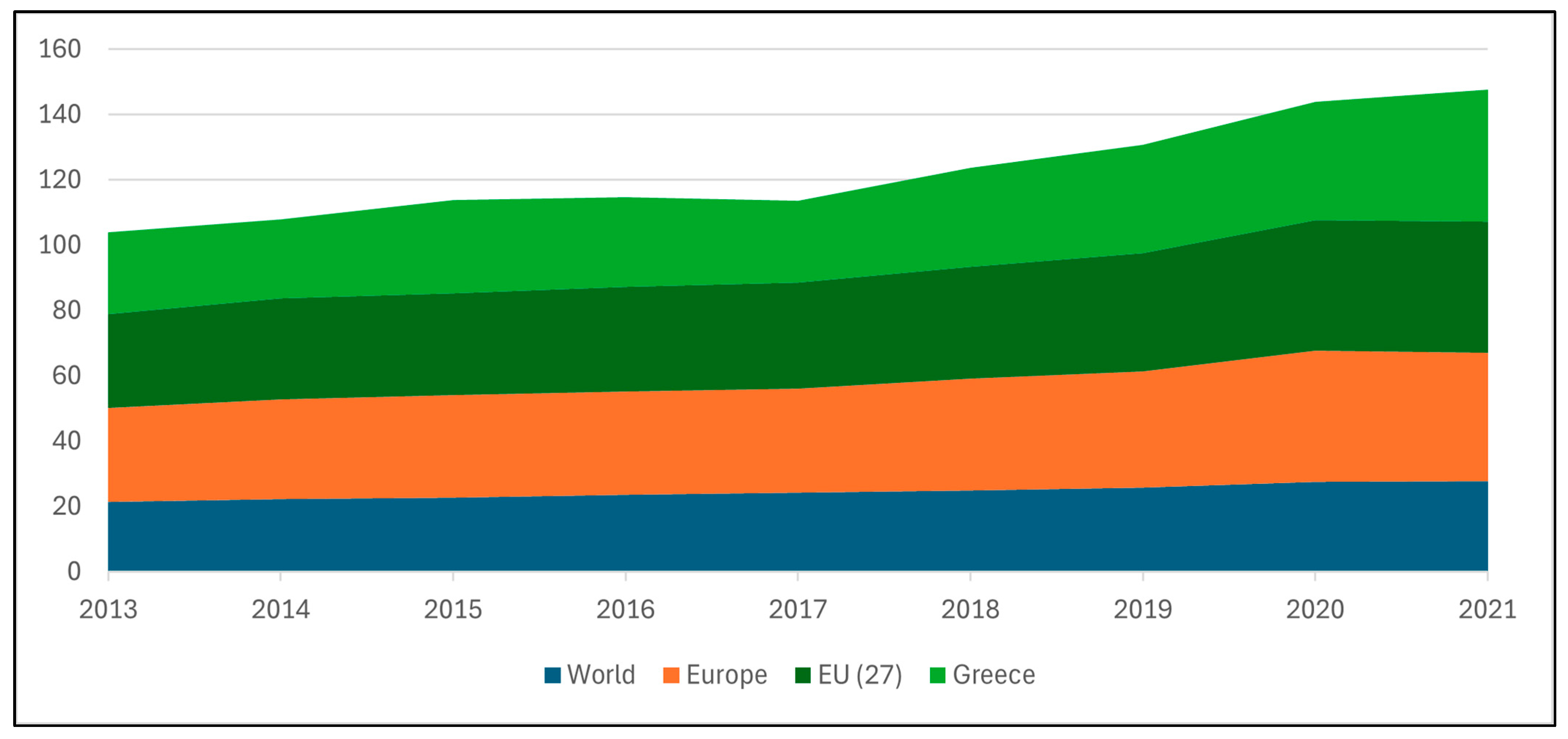

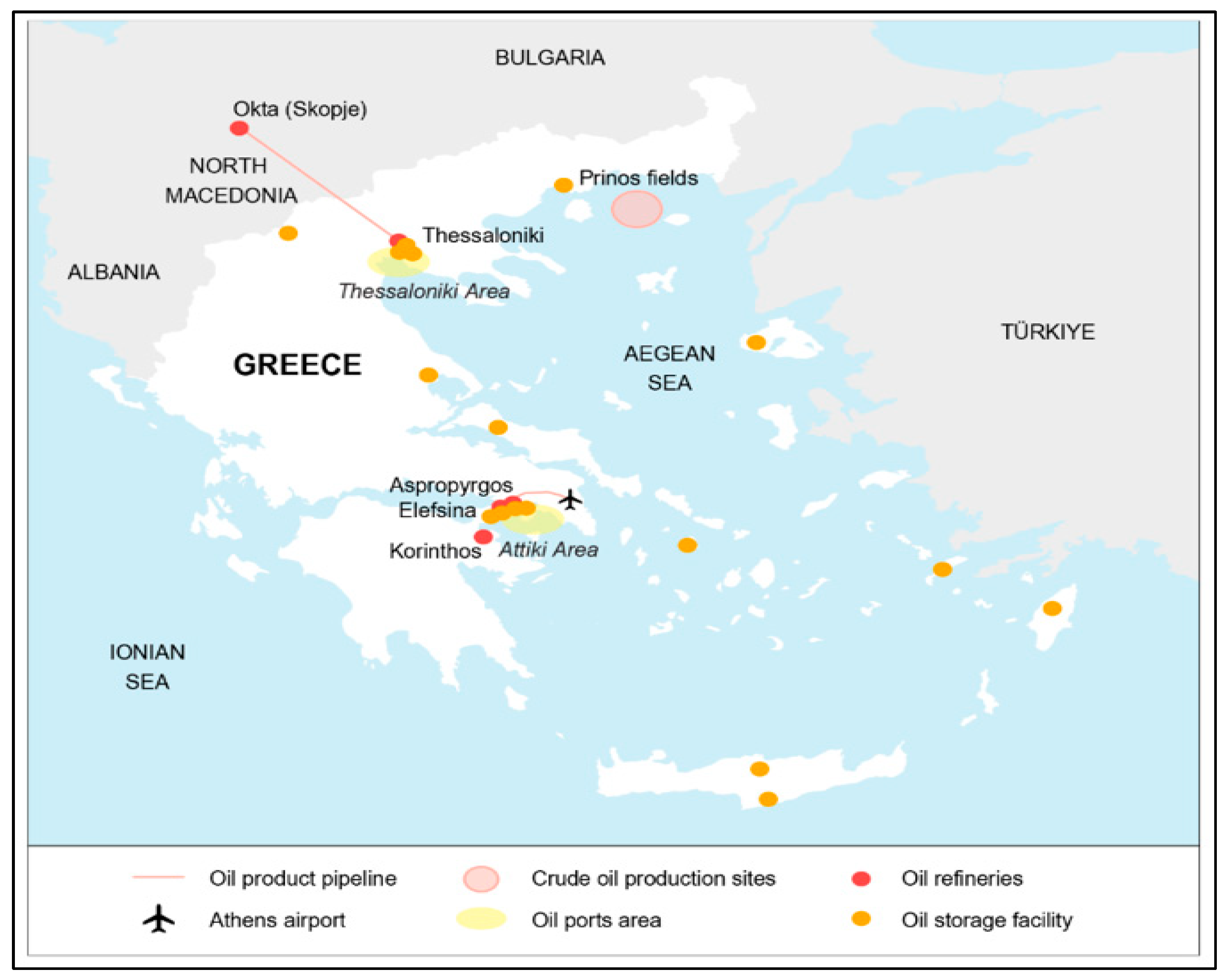
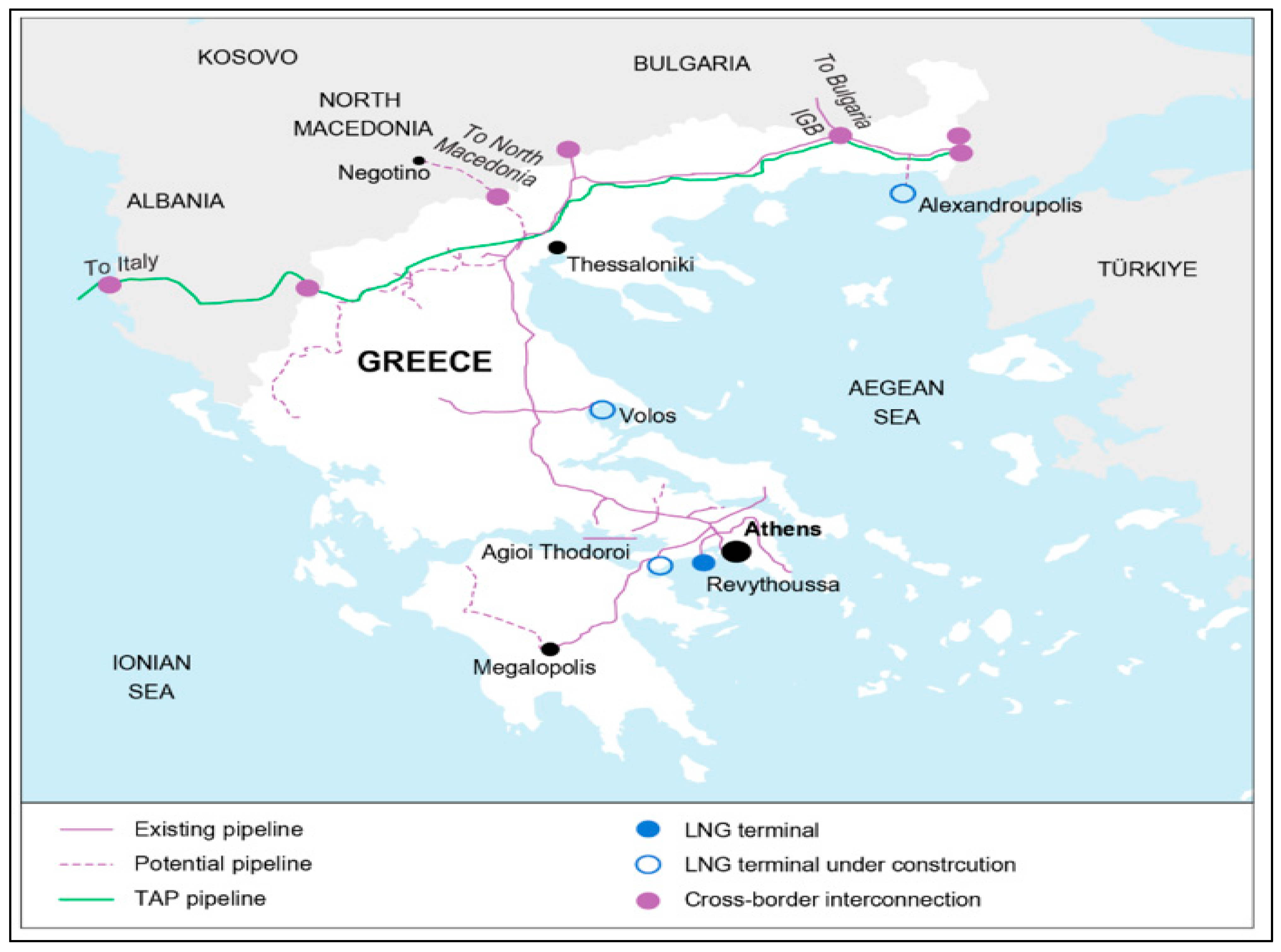
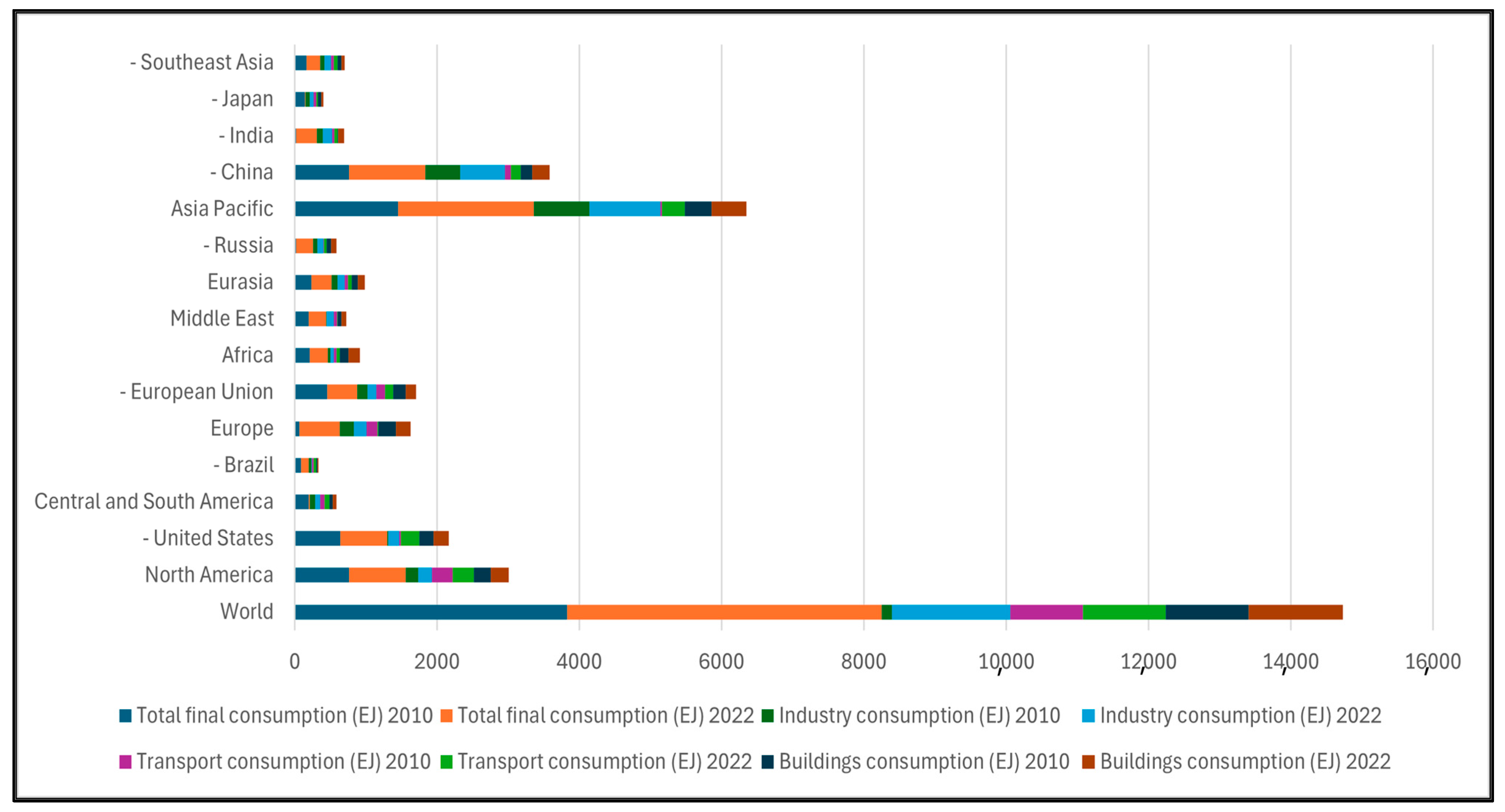

References
- Gunnarsdottir, I.; Davidsdottir, B.; Worrell, E.; Sigurgeirsdottir, S. Sustainable Energy Development: History of the Concept and Emerging Themes. Renew. Sustain. Energy Rev. 2021, 141, 110770. [Google Scholar] [CrossRef]
- Vera, I.; Langlois, L. Energy Indicators for Sustainable Development. Energy 2007, 32, 875–882. [Google Scholar] [CrossRef]
- Chatzinikolaou, D. H Ενεργειακή Μετάβαση Στην Ευρώπη Aπό Την Oπτική Της Διεθνούς Πολιτικής Oικονομίας, Των Επιχειρηματικών Oικοσυστημάτων Και Της Επιχειρηματικότητας [The Energy Transition in Europe from the Perspective of International Political Economy, Business Ecosystems and Entrepreneurship]. Doctoral Dissertation, Democritus University of Thrace, Department of Economics, Komotini, Greece, 2024. [Google Scholar]
- Chatzinikolaou, D.; Vlados, C. International Political Economy, Business Ecosystems, Entrepreneurship, and Sustainability: A Synthesis on the Case of the Energy Sector. Sustainability 2024, 16, 10092. [Google Scholar] [CrossRef]
- Ministry of Environment and Energy. Greece—Draft Updated NECP 2021–2030—European Commission; Hellenic Republic: Athens, Greece, 2023.
- Andrikopoulos, A.; Nastopoulos, C. Κρίση Και Ρεαλισμός [Crisis and Realism]; Propobos Publications: Athens, Greece, 2015; ISBN 978-618-5036-16-4. [Google Scholar]
- CIA Greece. World Factb; Central Intelligence Agency, Office of Public Affairs: Washington, DC, USA, 2022.
- Yanatma, S. Average Salary Rankings in Europe: Which Countries Pay the Highest?|Euronews. Available online: https://www.euronews.com/business/2024/12/24/average-earnings-rankings-in-europe-which-countries-pay-the-highest (accessed on 11 January 2025).
- Lewis, D.; Papadimitriou, E.; Cabeza Martinez, B.; de Dominicis, L.; Kovacic, M. EU Regional Competitiveness Index 2.0: 2022 Edition; A series of short papers on regional research and indicators produced by the Directorate-General for Regional and Urban Policy; Publications Office of the European Union: Luxembourg, 2023. [Google Scholar]
- Boden, M. Ris3 Implementation in Lagging Regions: Lessons from Eastern Macedonia and Thrace. Eur. Struct. Invest. Funds J. 2017, 5, 77–83. [Google Scholar]
- Chatzinikolaou, D.; Vlados, C. Weak Sustainable Development Trajectories and Evolving Organisational Physiologies: Empirical Evidence from Greece. In Business for Sustainability, Volume I; Vrontis, D., Thrassou, A., Efthymiou, L., Weber, Y., Shams, S.M.R., Tsoukatos, E., Eds.; Palgrave Studies in Cross-disciplinary Business Research, in Association with EuroMed Academy of Business; Springer International Publishing: Cham, Switzerland, 2023; pp. 201–226. ISBN 978-3-031-37360-2. [Google Scholar]
- Vasilakos, N. Energy Transition Challenges and Development Priorities for the Greek Energy Sector in the Coming Decade. Renew. Energy Law Policy Rev. 2019, 9, 32–38. [Google Scholar] [CrossRef]
- Moore, J. Predators and Prey: A New Ecology of Competition. Harv. Bus. Rev. 1993, 71, 75–86. [Google Scholar] [PubMed]
- Chatzinikolaou, D.; Vlados, C.; Kokkinaki, A. The Ecosystems Perspective in Energy Research: A New Field Is Born? Int. J. Energy Econ. Policy 2024, 15, 249–266. [Google Scholar] [CrossRef]
- International Energy Agency. Greece 2023 Energy Policy Review; IEA Energy Policy Reviews; IEA: Paris, France, 2023; ISBN 978-92-64-32569-2. [Google Scholar]
- European Commission. The European Green Deal; European Commission: Luxembourg, 2019.
- United Nations. Transforming Our World: The 2030 Agenda for Sustainable Development; A/RES/71/1, 3 October 2016 (The New York Declaration); United Nations: New York, NY, USA, 2015. [Google Scholar]
- World Commission on Environment and Development (Ed.) Our Common Future; Oxford Paperbacks; Oxford University Press: Oxford, UK; New York, NY, USA, 1987; ISBN 978-0-19-282080-8. [Google Scholar]
- United Nations. United Nations Framework Convention on Climate Change; United Nations: New York, NY, USA, 1992. [Google Scholar]
- United Nations. Development Programme. In World Energy Assessment: Energy and the Challenge of Sustainability; UNDP: New York, NY, USA, 2000; ISBN 92-1-126126-0. [Google Scholar]
- United Nations General Assembly. United Nations Millennium Declaration; United Nations General Assembly: New York, NY, USA, 2000. [Google Scholar]
- United Nations. Commission on Sustainable Development—Report on the 9th Session; United Nations: New York, NY, USA, 2001. [Google Scholar]
- Spalding-Fecher, R.; Winkler, H.; Mwakasonda, S. Energy and the World Summit on Sustainable Development: What Next? Energy Policy 2005, 33, 99–112. [Google Scholar] [CrossRef]
- Founding Conference. Available online: https://www.irena.org/About/History/Founding-Conference (accessed on 3 January 2025).
- International Atomic Energy Agency. Energy Indicators for Sustainable Development: Guidelines and Methodologies; International Atomic Energy Agency: Vienna, Austria, 2005; ISBN 92-0-116204-9. [Google Scholar]
- International Energy Agency. World Energy Outlook 2023; International Energy Agency (IEA), Directorate of Sustainability, Technology and Outlooks: Paris, France, 2023. [Google Scholar]
- International Energy Agency. World Energy Outlook 2020; International Energy Agency: Paris, France, 2020. [Google Scholar]
- International Energy Agency. World Energy Outlook 2016; International Energy Agency: Paris, France, 2016. [Google Scholar]
- United Nations. A Vision Statement by Ban Ki-Moon Secretary-General of the United Nations; United Nations: New York, NY, USA, 2011. [Google Scholar]
- Sorrell, S.; Dimitropoulos, J.; Sommerville, M. Empirical Estimates of the Direct Rebound Effect: A Review. Energy Policy 2009, 37, 1356–1371. [Google Scholar] [CrossRef]
- Herring, H.; Roy, R. Technological Innovation, Energy Efficient Design and the Rebound Effect. Technovation 2007, 27, 194–203. [Google Scholar] [CrossRef]
- Nelson, R.R.; Winter, S. An Evolutionary Theory of Economic Change; The Belknap Press of Harvard University Press: Cambridge, MA, USA; London, UK, 1982; ISBN 978-0-674-27228-6. [Google Scholar]
- Chatzinikolaou, D.; Vlados, C. Evolutionary Economics and the Stra.Tech.Man Approach of the Firm into Globalization Dynamics. Bus. Manag. Econ. Res. 2019, 5, 146–160. [Google Scholar] [CrossRef]
- Veblen, T. Why Is Economics Not an Evolutionary Science? Q. J. Econ. 1898, 12, 373–397. [Google Scholar] [CrossRef]
- Schumpeter, J. Capitalism, Socialism and Democracy; Edition published in the Taylor&Francis e-Library, 2003; Harper & Brothers: New York, NY, USA; London, UK, 1942; ISBN 0-203-20205-8. [Google Scholar]
- Schumpeter, J. Business Cycles: A Theoretical, Historical and Statistical Analysis of the Capitalist Process; McGraw-Hill: New York, NY, USA; London, UK, 1939. [Google Scholar]
- Tansley, A.G. The Use and Abuse of Vegetational Concepts and Terms. Ecology 1935, 16, 284–307. [Google Scholar] [CrossRef]
- Moore, J. The Death of Competition: Leadership and Strategy in the Age of Business Ecosystems, 1. paperback ed.; Harper Business: New York, NY, USA, 1996; ISBN 978-0-88730-850-5. [Google Scholar]
- Moore, J. Shared Purpose: A Thousand Business Ecosystems, a Connected Community, and the Future., 3rd ed.; First Ecosystem: Concord, MA, USA, 2015; ISBN 978-1-4905-0239-7. [Google Scholar]
- Iansiti, M.; Levien, R. Strategy as Ecology. Harv. Bus. Rev. 2004, 82, 68–81. [Google Scholar] [PubMed]
- Hajiyev, N.; Mansura, M.; Sverdlikov, E.; Safronov, R.; Vityutina, T. Oligopoly Trends in Energy Markets: Causes, Crisis of Competition, and Sectoral Development Strategies. Int. J. Energy Econ. Policy 2021, 11, 392–400. [Google Scholar] [CrossRef]
- Adu-Kankam, K.O.; Camarinha-Matos, L.M. Emerging Community Energy Ecosystems: Analysis of Organizational and Governance Structures of Selected Representative Cases. In Technological Innovation for Industry and Service Systems. DoCEIS 2019. IFIP Advances in Information and Communication Technology; Camarinha-Matos, L.M., Almeida, R., Oliveira, J., Eds.; Springer: Cham, Switzerland, 2019; Volume 553, pp. 24–40. ISBN 978-3-030-17771-3. [Google Scholar]
- Korhonen, J.; Wihersaari, M.; Savolainen, I. Industrial Ecosystem in the Finnish Forest Industry: Using the Material and Energy Flow Model of a Forest Ecosystem in a Forest Industry System. Ecol. Econ. 2001, 39, 145–161. [Google Scholar] [CrossRef]
- Hellström, M.; Tsvetkova, A.; Gustafsson, M.; Wikström, K. Collaboration Mechanisms for Business Models in Distributed Energy Ecosystems. J. Clean. Prod. 2015, 102, 226–236. [Google Scholar] [CrossRef]
- Tsvetkova, A.; Schmutzler, J.; Pugh, R. (Eds.) Entrepreneurial Ecosystems Meet Innovation Systems: Synergies, Policy Lessons and Overlooked Dimensions; New Horizons in Regional Science; Edward Elgar Publishing: Cheltenham, UK; Northampton, MA, USA, 2020; ISBN 978-1-78990-117-7. [Google Scholar]
- Slocum, T. Electric Utility Deregulation and the Myths of the Energy Crisis. Bull. Sci. Technol. Soc. 2001, 21, 473–481. [Google Scholar] [CrossRef]
- Baker, S.H.; Carley, S.; Konisky, D.M. Energy Insecurity and the Urgent Need for Utility Disconnection Protections. Energy Policy 2021, 159, 112663. [Google Scholar] [CrossRef]
- Mayer, A. Fossil Fuel Dependence and Energy Insecurity. Energy Sustain. Soc. 2022, 12, 27. [Google Scholar] [CrossRef]
- Wang, W.; Fan, L.W.; Zhou, P. Evolution of Global Fossil Fuel Trade Dependencies. Energy 2022, 238, 121924. [Google Scholar] [CrossRef]
- Korhonen, J. Co-Production of Heat and Power: An Anchor Tenant of a Regional Industrial Ecosystem. J. Clean. Prod. 2001, 9, 509–517. [Google Scholar] [CrossRef]
- Hancock, K.J.; Vivoda, V. International Political Economy: A Field Born of the OPEC Crisis Returns to Its Energy Roots. Energy Res. Soc. Sci. 2014, 1, 206–216. [Google Scholar] [CrossRef]
- United Nations. Adoption of the Paris Agreement; United Nations: New York, NY, USA, 2015. [Google Scholar]
- Antimiani, A.; Costantini, V.; Paglialunga, E. Fossil Fuels Subsidy Removal and the EU Carbon Neutrality Policy. Energy Econ. 2023, 119, 106524. [Google Scholar] [CrossRef]
- McCauley, D. Energy Justice: Re-Balancing the Trilemma of Security, Poverty and Climate Change; Palgrave pivot; Palgrave Macmillan: Cham, Switzerland, 2017; ISBN 978-3-319-62494-5. [Google Scholar]
- Vlados, C.; Chatzinikolaou, D. Macro, Meso, and Micro Policies for Strengthening Entrepreneurship: Towards an Integrated Competitiveness Policy. J. Bus. Econ. Policy 2020, 7, 1–12. [Google Scholar] [CrossRef]
- Bradford, T. The Energy System: Technology, Economics, Markets and Policy; MIT Press: Cambridge, MA, USA; London, UK, 2018; ISBN 978-0-262-03752-5. [Google Scholar]
- Carayannis, E.; Grigoroudis, E.; Campbell, D.; Meissner, D.; Stamati, D. The Ecosystem as Helix: An Exploratory Theory-Building Study of Regional Co-Opetitive Entrepreneurial Ecosystems as Quadruple/Quintuple Helix Innovation Models. RD Manag. 2018, 48, 148–162. [Google Scholar] [CrossRef]
- Vlados, C.; Chatzinikolaou, D.; Kapaltzoglou, F. Energy Market Liberalisation in Greece: Structures, Policy and Prospects. Int. J. Energy Econ. Policy 2021, 11, 115–126. [Google Scholar] [CrossRef]
- Vlados, C.; Chatzinikolaou, D. Developments on Helix Theory: Exploring a Micro-Evolutionary Repositioning in Stra.Tech.Man Terms. Int. J. World Policy Dev. Stud. 2019, 5, 87–99. [Google Scholar] [CrossRef][Green Version]
- Chatzinikolaou, D.; Vlados, C. Schumpeter, Neo-Schumpeterianism, and Stra.Tech.Man Evolution of the Firm. Issues Econ. Bus. Int. Econ. Bus. 2019, 5, 80–102. [Google Scholar] [CrossRef]
- Dopfer, K.; Foster, J.; Potts, J. Micro-Meso-Macro. J. Evol. Econ. 2004, 14, 263–279. [Google Scholar] [CrossRef]
- Bögel, P.; Upham, P.; Shahrokni, H.; Kordas, O. What Is Needed for Citizen-Centered Urban Energy Transitions: Insights on Attitudes towards Decentralized Energy Storage. Energy Policy 2021, 149, 112032. [Google Scholar] [CrossRef]
- Fotopoulou, M.; Pediaditis, P.; Skopetou, N.; Rakopoulos, D.; Christopoulos, S.; Kartalidis, A. A Review of the Energy Storage Systems of Non-Interconnected European Islands. Sustainability 2024, 16, 1572. [Google Scholar] [CrossRef]
- Olabi, A.G.; Wilberforce, T.; Sayed, E.T.; Abo-Khalil, A.G.; Maghrabie, H.M.; Elsaid, K.; Abdelkareem, M.A. Battery Energy Storage Systems and SWOT (Strengths, Weakness, Opportunities, and Threats) Analysis of Batteries in Power Transmission. Energy 2022, 254, 123987. [Google Scholar] [CrossRef]
- Duch-Brown, N.; Rossetti, F. Digital Platforms across the European Regional Energy Markets. Energy Policy 2020, 144, 111612. [Google Scholar] [CrossRef]
- Kloppenburg, S.; Boekelo, M. Digital Platforms and the Future of Energy Provisioning: Promises and Perils for the next Phase of the Energy Transition. Energy Res. Soc. Sci. 2019, 49, 68–73. [Google Scholar] [CrossRef]
- Glachant, J.-M.; Rossetto, N. New Transactions in Electricity: Peer-to-Peer and Peer-to-X. Econ. Energy Environ. Policy 2021, 10, 41–55. [Google Scholar] [CrossRef]
- Ma, Z. Business Ecosystem Modeling- the Hybrid of System Modeling and Ecological Modeling: An Application of the Smart Grid. Energy Inform. 2019, 2, 35. [Google Scholar] [CrossRef]
- Ford, R.; Maidment, C.; Vigurs, C.; Fell, M.J.; Morris, M. Smart Local Energy Systems (SLES): A Framework for Exploring Transition, Context, and Impacts. Technol. Forecast. Soc. Chang. 2021, 166, 120612. [Google Scholar] [CrossRef]
- Our World in Data. Crude Oil Prices. Available online: https://ourworldindata.org/grapher/crude-oil-prices (accessed on 3 February 2024).
- Our World in Data. Crude Oil Spot Prices. Available online: https://ourworldindata.org/grapher/crude-oil-spot-prices?time=earliest (accessed on 3 February 2024).
- Our World in Data. Fossil Fuel Price Index. Available online: https://ourworldindata.org/grapher/fossil-fuel-price-index (accessed on 3 February 2024).
- Our World in Data. Natural Gas Prices. Available online: https://ourworldindata.org/grapher/natural-gas-prices (accessed on 3 February 2024).
- Our World in Data. World Crude Oil Price vs. Oil Consumption. Available online: https://ourworldindata.org/grapher/world-crude-oil-price-vs-oil-consumption (accessed on 3 February 2024).
- Directorate-General for Energy. EU Energy in Figures: Statistical Pocketbook 2023; European Commission, Publications Office of the European Union: Luxembourg, 2023.
- IRENA. Renewable Energy Statistics 2023; International Renewable Energy Agency (IRENA): Abu Dhabi, United Arab Emirates, 2023. [Google Scholar]
- Our World in Data. Share of Electricity Generated by Low-Carbon Sources. Available online: https://ourworldindata.org/grapher/share-electricity-low-carbon?tab=chart&country=GRC~OWID_EU27 (accessed on 26 January 2024).
- Our World in Data. Per Capita Electricity Generation. Available online: https://ourworldindata.org/grapher/per-capita-electricity-generation?tab=chart&country=GRC~OWID_EU27 (accessed on 26 January 2024).
- Our World in Data. Electricity Production by Source. Available online: https://ourworldindata.org/grapher/electricity-prod-source-stacked?country=GRC~OWID_EU27 (accessed on 26 January 2024).
- Our World in Data. Electricity Generation. Available online: https://ourworldindata.org/grapher/electricity-generation?tab=chart&country=GRC~OWID_EU27 (accessed on 26 January 2024).
- Hellenic Energy Exchange. Annual Report: 2022; Hellenic Energy Exchange: Athens, Greece, 2022. [Google Scholar]
- International Energy Agency. Greece 2023; International Energy Agency (IEA): Paris, France, 2023. [Google Scholar]
- Ρυθμιστική Aρχή Ενέργειας. Έκθεση Πεπραγμένων 2021; Ρυθμιστική Aρχή Ενέργειας: Aθήνα, Greece, 2021. [Google Scholar]
- Dianeosis, O. Τομέας Ενέργειας Στην Ελλάδα: Τάσεις, Προοπτικές Και Προκλήσεις [The Energy Sector in Greece: Trends, Prospects and Challenges]; Regulatory Authority for Energy: Athens, Greece, 2021. [Google Scholar]
- Our World in Data. Energy Use per Person. Available online: https://ourworldindata.org/grapher/per-capita-energy-use?tab=chart&country=GRC~OWID_EU27 (accessed on 26 January 2024).
- Our World in Data. Primary Energy Consumption. Available online: https://ourworldindata.org/grapher/primary-energy-cons?tab=chart&country=GRC~OWID_EU27 (accessed on 26 January 2024).
- Our World in Data. Annual Change in Primary Energy Consumption. Available online: https://ourworldindata.org/grapher/change-energy-consumption?country=OWID_EU27~GRC (accessed on 26 January 2024).
- Our World in Data. Energy Consumption by Source. Available online: https://ourworldindata.org/grapher/energy-consumption-by-source-and-country?stackMode=absolute&country=GRC~OWID_EU27~OWID_WRL (accessed on 26 January 2024).
- Our World in Data. Share of Primary Energy Consumption from Fossil Fuels. Available online: https://ourworldindata.org/grapher/fossil-fuels-share-energy?tab=chart&country=GRC~OWID_EU27 (accessed on 26 January 2024).
- Our World in Data. Share of Primary Energy Consumption from Low-Carbon Sources. Available online: https://ourworldindata.org/grapher/low-carbon-share-energy?tab=chart&country=GRC~OWID_EU27 (accessed on 26 January 2024).
- Korhonen, J.; Snäkin, J. Quantifying the Relationship of Resilience and Eco-Efficiency in Complex Adaptive Energy Systems. Ecol. Econ. 2015, 120, 83–92. [Google Scholar] [CrossRef]
- Ruggiero, S.; Varho, V.; Rikkonen, P. Transition to Distributed Energy Generation in Finland: Prospects and Barriers. Energy Policy 2015, 86, 433–443. [Google Scholar] [CrossRef]
- Kotilainen, K.; Sommarberg, M.; Järventausta, P.; Aalto, P. Prosumer Centric Digital Energy Ecosystem Framework. In Proceedings of the 8th International Conference on Management of Digital EcoSystems—MEDES, Hendaye, France, 2–4 November 2016; ACM Press: Biarritz, France, 2016; pp. 47–51. [Google Scholar]
- Lavrijssen, S.; Parra, A.C. Radical Prosumer Innovations in the Electricity Sector and the Impact on Prosumer Regulation. Sustainability 2017, 9, 1207. [Google Scholar] [CrossRef]
- González-Carrasco, V.; Robina-Ramírez, R.; Gibaja-Romero, D.-E.; Sánchez-Oro Sánchez, M. The Quintuple Helix Model: Cooperation System for a Sustainable Electric Power Industry in Mexico. Front. Sustain. Energy Policy 2023, 1, 1047675. [Google Scholar] [CrossRef]
- Palmatier, R.W.; Houston, M.B.; Hulland, J. Review Articles: Purpose, Process, and Structure. J. Acad. Mark. Sci. 2018, 46, 1–5. [Google Scholar] [CrossRef]
- Johnson, T.P. Snowball Sampling: Introduction. In Wiley StatsRef: Statistics Reference Online; Kenett, R.S., Longford, N.T., Piegorsch, W.W., Ruggeri, F., Eds.; Wiley: Hoboken, NJ, USA, 2014; ISBN 978-1-118-44511-2. [Google Scholar]
- Mishler, E.G. Research Interviewing: Context and Narrative; First Harvard University Press paperback edition. Originally published in 1986; Harvard University Press: Cambridge, MA, USA, 1991. [Google Scholar]
- Lingard, L.; Albert, M.; Levinson, W. Qualitative Research: Grounded Theory, Mixed Methods, and Action Research. BMJ 2008, 337, 459–461. [Google Scholar] [CrossRef]
- Somekh, B. Action Research: A Methodology for Change and Development; Doing qualitative research in educational settings; Open University Press: Maidenhead, UK, 2006; ISBN 978-0-335-21659-8. [Google Scholar]
- Lewin, K. Action Research and Minority Problems. J. Soc. Issues 1946, 2, 34–46. [Google Scholar] [CrossRef]
- Winter, R. “Dilemma Analysis”: A Contribution to Methodology for Action Research. Camb. J. Educ. 1982, 12, 161–174. [Google Scholar] [CrossRef]
- Eden, C.; Ackermann, F. Theory into Practice, Practice to Theory: Action Research in Method Development. Eur. J. Oper. Res. 2018, 271, 1145–1155. [Google Scholar] [CrossRef]
- Corbin, J.M.; Strauss, A.L. Basics of Qualitative Research: Techniques and Procedures for Developing Grounded Theory; Sage: New York, NY, USA, 2015; ISBN 978-1-4129-9746-1. [Google Scholar]
- Saunders, M.N.K.; Lewis, P.; Thornhill, A. Research Methods for Business Students, 8th ed.; Pearson: New York, NY, USA, 2019; ISBN 978-1-292-20878-7. [Google Scholar]
- Psarros, G.N.; Papathanassiou, S.A. Electricity Storage Requirements to Support the Transition towards High Renewable Penetration Levels—Application to the Greek Power System. J. Energy Storage 2022, 55, 105748. [Google Scholar] [CrossRef]
- Superchi, F.; Moustakis, A.; Pechlivanoglou, G.; Bianchini, A. On the Importance of Degradation Modeling for the Robust Design of Hybrid Energy Systems Including Renewables and Storage. Appl. Energy 2025, 377, 124645. [Google Scholar] [CrossRef]
- Boulogiorgou, D.; Ktenidis, P. TILOS Local Scale Technology Innovation Enabling Low Carbon Energy Transition. Renew. Energy 2020, 146, 397–403. [Google Scholar] [CrossRef]
- Katsaprakakis, D.A.; Proka, A.; Zafirakis, D.; Damasiotis, M.; Kotsampopoulos, P.; Hatziargyriou, N.; Dakanali, E.; Arnaoutakis, G.; Xevgenos, D. Greek Islands’ Energy Transition: From Lighthouse Projects to the Emergence of Energy Communities. Energies 2022, 15, 5996. [Google Scholar] [CrossRef]
- Nikas, A.; Stavrakas, V.; Arsenopoulos, A.; Doukas, H.; Antosiewicz, M.; Witajewski-Baltvilks, J.; Flamos, A. Barriers to and Consequences of a Solar-Based Energy Transition in Greece. Environ. Innov. Soc. Transit. 2020, 35, 383–399. [Google Scholar] [CrossRef]
- Vlachou, A.; Pantelias, G. Energy Transitions: The Case of Greece with a Special Focus on the Role of the EU ETS. Sci. Soc. 2022, 86, 516–545. [Google Scholar] [CrossRef]
- ITIF. The 2021 Global Energy Innovation Index: National Contributions to the Global Clean Energy Innovation System; Information Technology & Innovation Foundation (ITIF): Washington, DC, USA, 2021. [Google Scholar]
- Global Energy Institute. International Index of Energy Security Risk: Assessing Risk in a Global Energy Market; Global Energy Institute: London, UK, 2020. [Google Scholar]
- Chatzinikolaou, D.; Vlados, C. On a New Sustainable Energy Policy: Exploring a Macro-Meso-Micro Synthesis. Energies 2025, 18, 260. [Google Scholar] [CrossRef]
- Norman, W. Ib Vogt Sells 780 MW Greek Solar, Storage Portfolio to Faria Renewables. Available online: https://www.pv-tech.org/ib-vogt-sells-780mw-greek-solar-storage-portfolio-to-faria-renewables/ (accessed on 27 January 2025).
- Greece: Ib Vogt Sells 780 MW Solar and Storage Portfolio to Faria Renewables. Available online: https://www.pveurope.eu/financing/greece-ib-vogt-sells-780-mw-solar-and-storage-portfolio-faria-renewables (accessed on 27 January 2025).
- Nordex SE PPC Renewables Places Three Orders with Nordex Group Totalling 100 MW Nominal Capacity in Greece—Renewablepress. Available online: https://www.renewablepress.com/energy/press-release-8358-ppc-renewables-places-three-orders-with-nordex-group-totalling-100-mw-nominal-capacity-in-greece (accessed on 27 January 2025).
- Murray, C. Greece Gets State Aid Approval from EU for 900 MW Energy Storage Pipeline. Available online: https://www.energy-storage.news/greece-gets-state-aid-approval-from-eu-for-900mw-energy-storage-pipeline/ (accessed on 27 January 2025).
- Dandolou, N. National Bank of Greece Finances First Energy Storage Project in Country. Available online: https://www.ot.gr/2025/01/21/english-edition/national-bank-of-greece-finances-first-energy-storage-project-in-country/ (accessed on 27 January 2025).
- Elsewedy Electric Achieves Financial Close on Greece’s First Large-Scale Battery Storage Project. Available online: https://www.zawya.com/en/business/energy/elsewedy-electric-achieves-financial-close-on-greeces-first-large-scale-battery-storage-project-hjkrakr0 (accessed on 27 January 2025).
- Greece Launches C&I Battery Storage Subsidy Program. Available online: https://www.pv-magazine.com/2025/01/14/greece-launches-ci-battery-storage-subsidy-program/ (accessed on 27 January 2025).
- Maisch, M. Greece Launches 200 MW Battery Storage Auction. Available online: https://www.ess-news.com/2024/11/12/greece-launches-200-mw-battery-storage-auction/ (accessed on 27 January 2025).
- European Parliament Infographic: Recovery and Resilience Facility|EPRS|European Parliament. Available online: https://www.europarl.europa.eu/thinktank/infographics/RRF/recovery-resilience-facility/?lang=en#recovery-resilience-facility (accessed on 9 February 2024).


| I. Supply (SU) |
| Geopolitical shifts and energy prices {SU1}|Dependence on external energy sources {SU2}|Lack of domestic energy production {SU3}|Regulatory and bureaucratic barriers {SU4}|Market manipulation and limited competition {SU5}|Impacts of European energy policies {SU6}|Speculation and market volatility {SU7} |
| II. Production (PR) |
| Environmental sensitivity of Europe versus Eurasia {PR1}|Challenges of Greece’s digital energy transition {PR2}|Geographic advantage of Greece for RES {PR3}|Renewable energy investments during economic recovery {PR4}|Network capacity and renewable energy production {PR5}|Decarbonization and adaptation of the energy mix {PR6}|Economic interests and renewable energy investments {PR7}|Impacts of reduced demand for fossil fuels {PR8} |
| III. Distribution (DI) |
| Gradual transition of the Greek energy market from immaturity to maturity {DI1}|Importance of digital transformation for further evolution of the energy market {DI2}|Influence of economic crises and market dominance on energy strategies {DI3}|High investment costs for smart grids and local opposition {DI4}|Impact of generational gaps in digital literacy on the energy market {DI5}|Lack of clear communication about energy costs and benefits {DI6}|Low productivity and diversification due to fuel market saturation {DI7}|Reduced labor demand in the energy sector due to technological improvements {DI8}|Complex and opaque pricing mechanisms in fuel trading {DI9} |
| IV. Consumption (CO) |
| Increased risk due to dependence on energy imports {CO1}|Outsourcing and lack of storage systems {CO2}|National versus European energy policies {CO3}|Impacts of climate change on energy consumption patterns {CO4}|Technological changes in energy consumption {CO5}|Economic factors and energy consumption {CO6}|Different heating sources across Europe {CO7}|Recent increase in energy usage {CO8}|Increased focus on electricity {CO9} |
Disclaimer/Publisher’s Note: The statements, opinions and data contained in all publications are solely those of the individual author(s) and contributor(s) and not of MDPI and/or the editor(s). MDPI and/or the editor(s) disclaim responsibility for any injury to people or property resulting from any ideas, methods, instructions or products referred to in the content. |
© 2025 by the author. Licensee MDPI, Basel, Switzerland. This article is an open access article distributed under the terms and conditions of the Creative Commons Attribution (CC BY) license (https://creativecommons.org/licenses/by/4.0/).
Share and Cite
Chatzinikolaou, D. Integrating Sustainable Energy Development with Energy Ecosystems: Trends and Future Prospects in Greece. Sustainability 2025, 17, 1487. https://doi.org/10.3390/su17041487
Chatzinikolaou D. Integrating Sustainable Energy Development with Energy Ecosystems: Trends and Future Prospects in Greece. Sustainability. 2025; 17(4):1487. https://doi.org/10.3390/su17041487
Chicago/Turabian StyleChatzinikolaou, Dimos. 2025. "Integrating Sustainable Energy Development with Energy Ecosystems: Trends and Future Prospects in Greece" Sustainability 17, no. 4: 1487. https://doi.org/10.3390/su17041487
APA StyleChatzinikolaou, D. (2025). Integrating Sustainable Energy Development with Energy Ecosystems: Trends and Future Prospects in Greece. Sustainability, 17(4), 1487. https://doi.org/10.3390/su17041487






